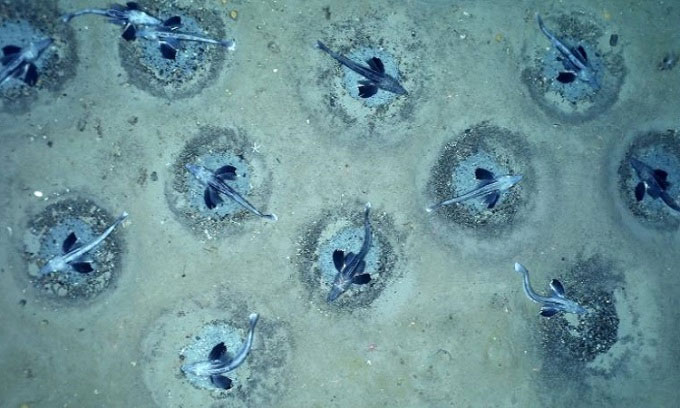Detecting a population of 60 million ice fish nests on the bottom of the Antarctic sea
Researchers announced the discovery of a huge population of ice fish (notothenioids) in the Weddell Sea south of Antarctica in the journal Current Biology on January 13.
The team estimates that the icefish population spans at least 240 square kilometers and includes about 60 million active nests. This unprecedentedly large population has a biomass of more than 60,000 tons.

Ice fish are guarding the eggs in the nest.
"Our most important finding is the existence of such a large population of spawning icefish," said researcher Autun Purser of the Alfred Wegener Institute in Bremerhaven, Germany. "We have observed dozens of nests elsewhere in Antarctica, but this finding is many times larger in scale."
Purser and his colleagues found the population of ice fish while surveying the Filchner ice shelf using the Ocean Bottom Observation and Depth Measurement System (OFOBS). Basically, this is a large piece of equipment that weighs a ton. The team dragged the instrument behind the icebreaker RV Polarstern at 4 km/h, at an altitude of 1.5 - 2.5 m above the seabed to film and collect sonar data. .
Scientists are especially interested in the seafloor in this area because they know there is an upwelling water 2 degrees Celsius warmer than the surrounding water. However, the new discovery was beyond their imagination. Purser's team doesn't think there are any fish nest ecosystems in the area.
Most of the nests they found contained one adult fish guarding more than 1,700 eggs. They also observed numerous carcasses in and near nest populations, indicating that these fish play an important role in the larger food web. Although more research is needed, Purser and his colleagues speculate that icefish populations are a source of food for predators such as Weddell seals.
"Many Weddell seals spend most of their time near nests. We know this from old and new tracking data from our vessel. The nests are located precisely in warm upwelling waters. That's there. This could be a coincidence and needs more research, but seal data shows that they dive to the depths of fish nests and eat ice fish," Purser said.
The discovery reveals a unique ecosystem, providing additional data to establish a marine protected area in the Southern Ocean. The team is deploying two camera systems to monitor the icefish nests until the research vessel returns. They hope to be able to take pictures several times a day, thereby learning more about the mechanics of the newly discovered ecosystem. Purser shared, he planned to return in April 2022 to survey the seabed in areas north of the Weddell Sea.
- Detecting signs of life in the bottom of the Antarctic lake
- Elephant seals help study the Antarctic bottom
- Antarctic Antarctic fish is about to be extinct
- What is the bottom of the Antarctic sea?
- Mystery 'underworld' on the bottom of Antarctica
- The deepest water in the world disappears mysteriously
- Incredibly miraculous in the waters of the West Coast of the United States
- Discover a rare hand-walking fish species in the Tasmanian sea floor
- Why lion fish are destructive compared to other predators
- Antarctic fish's blood has antifreeze
- Huge volcano in the bottom of the Antarctic sea
- The bigger the population, the faster the end of the world
 Surprised: Fish that live in the dark ocean still see colors
Surprised: Fish that live in the dark ocean still see colors Japan suddenly caught the creature that caused the earthquake in the legend
Japan suddenly caught the creature that caused the earthquake in the legend A series of gray whale carcasses washed ashore on California's coast
A series of gray whale carcasses washed ashore on California's coast Compare the size of shark species in the world
Compare the size of shark species in the world